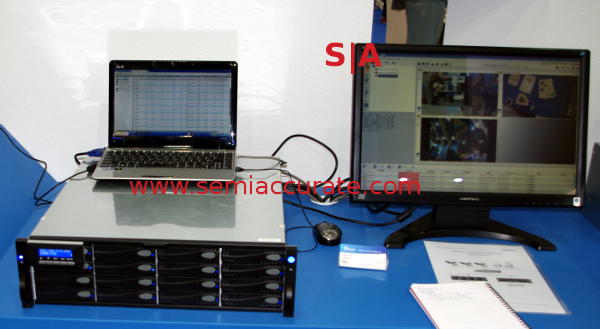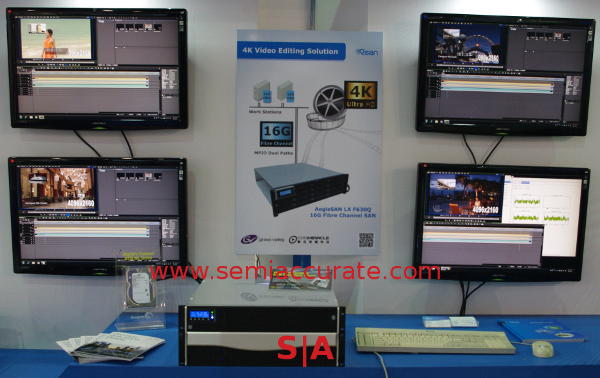![]() QSAN was showing off a lot of big SAN boxes at Computex with some impressive features. As with most large storage boxes, the devil is in the details and SemiAccurate thinks Qsan has some nice technology for those details.
QSAN was showing off a lot of big SAN boxes at Computex with some impressive features. As with most large storage boxes, the devil is in the details and SemiAccurate thinks Qsan has some nice technology for those details.
To start off with, Qsan is the small player in the field and like most up and coming vendors, they offer more for less. That starts off with a lot of the ‘optional’ features of the big guys like Snapshoting, DeDup, SSD caches, and thin provisioning are included in the purchase price. In short they throw in the full software suite for no additional charge. If you have ever looked at the cost of SAN boxes, the price tags before the options will make your eyes water and it just goes up from there.
This isn’t to say that Qsan has barebones offerings, their boxes are pretty fully featured with two things that stand out to SemiAccurate, QiSOL and ZFS. QiSOL stands for Qsan iSCSI Offload Engine and it does just that but in an interesting way. The CPU load of a SAN is not light but isn’t exactly HPC workload heavy.
One problem that SANs run into that other workloads don’t see as much is tight latency requirements. Throughput is fine and dandy for a storage box but high throughput with high latency doesn’t cut it for most enterprises. Click, wait, wait, wait, wait, firehose of data is not an acceptable performance model, it tends to get people fired.
QiSOL deals with this in an interesting way, they dedicate one core of the Xeon CPU only to dealing with requests. This fixes latency and ensures that the requests will be dealt with in a timely manner. If Qsan did their job right and there is more CPU power than incoming requests, latencies should be both fairly consistent and not very high.
The other useful bit of tech that Qsan uses is ZFS, an interesting choice in light of their Linux-based systems. If you don’t know about ZFS this won’t interest you much but those versed in file system minutia will likely drool over ZFS as a base SAN file system. Qsan keeps their own kernel and maintains the integration so it should be immune to the Oracle induced open source roadblocks and headaches.
Back to the products, the first one Qsan was showing off was the AegisSAN Q500, the mid-range SAN box in their lineup. It is a 4U 24 drive box that can support eight chained storage units via dual SAS connections for a total of 256 HDDs from one unit. So far that is pretty standard for the space, these are not big number for the large SAN boxes.

iSCSI based cameras, not IP-based as you would expect
One of the key markets for Qsan is surveillance and that was the first demo shown at Computex. The twist with this one was that the cameras, Bosch units in this case, are iSCSI based. This means the cameras can DMA directly into storage and do other tricks that normally require a lot of CPU overhead from a camera controller or worse yet the storage box itself. The down side to this is that you are looking at a much more complex setup versus a more generic IP camera. If you have the skills to set an iSCSI SAN up like this, it does seem to be a better way to go.

4x 4K streams edited in realtime
Moving up the stack we come to the AegisSAN LX, in this case an F630Q model with two 16Gbps FC connectors. The demo at Computex had one of the hot terms of the show, 4K video, specifically four 4K video streams at once. This may not sound impressive but the demo was editing those four 4K streams in realtime from a single SAN box, quite a bit more impressive than just playback. TV and cable stations drool over this kind of stuff, and if a single LX can do 4x 4K it can do a whole lot of 1080p streams.
The last demo was a little less visually appealing but involved a P600Q, essentially a F630Q with 10GbE instead of 16Gb FC links. Qsan was showing off one of the enterprise admin’s worst nightmares, booting of VDI VMs in the morning. This is the situation where in a short time span, say 8-9am, an enterprise with wide VDI deployments has to boot hundreds or thousands of VMs nearly at once. This takes a huge toll on storage subsystems and can separate the proverbial men from the boys.
Qsan was showing off the simultaneous booting of 300 VMs from that aforementioned P600Q box. Please note that this is not running 300 VMs on that box, just the storage side of things, IE serving them up to the machines running them. While it is a much easier task than running 300 VMs, it is still more than enough to bring most boxes to their knees. This is where SSD caching, QiSOL, and the other tricks all matter, and matter a lot. While we do realize that the real world is very different from a scripted demo, Qsan’s SANs did service 300 VDI boots at the same time.S|A
Have you signed up for our newsletter yet?
Did you know that you can access all our past subscription-only articles with a simple Student Membership for 100 USD per year? If you want in-depth analysis and exclusive exclusives, we don’t make the news, we just report it so there is no guarantee when exclusives are added to the Professional level but that’s where you’ll find the deep dive analysis.
Charlie Demerjian
Latest posts by Charlie Demerjian (see all)
- AMD outs MI300 plans… sort of - Apr 11, 2024
- Qualcomm is planning a lot of Nuvia/X-Elite announcements - Mar 25, 2024
- Why is there an Altera FPGA on QTS Birch Stream boards? - Mar 12, 2024
- Doogee (Almost) makes the phone we always wanted - Mar 11, 2024
- Intel Birch Stream Boards Speak From The SIde - Mar 6, 2024